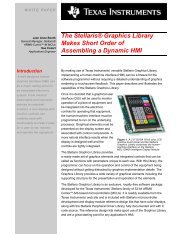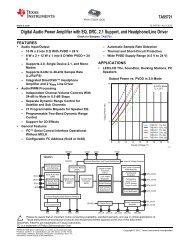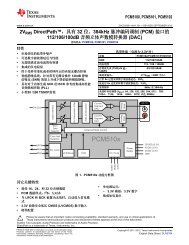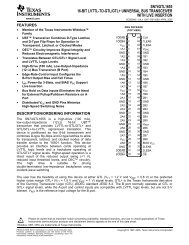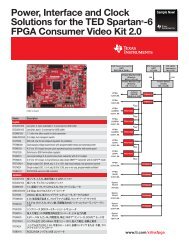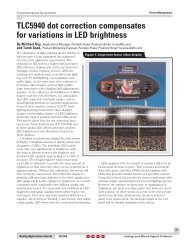DN508 -- Frequency Scanning using CC430Fx ... - Texas Instruments
DN508 -- Frequency Scanning using CC430Fx ... - Texas Instruments
DN508 -- Frequency Scanning using CC430Fx ... - Texas Instruments
You also want an ePaper? Increase the reach of your titles
YUMPU automatically turns print PDFs into web optimized ePapers that Google loves.
Design Note <strong>DN508</strong><br />
<strong>Frequency</strong> <strong>Scanning</strong> <strong>using</strong> <strong>CC430Fx</strong>, CC110x, and CC111xFx<br />
By Siri Johnsrud<br />
Keywords<br />
• <strong>CC430Fx</strong><br />
• CC1100<br />
• CC1100E<br />
• CC1101<br />
1 Introduction<br />
The purpose of this design note is to show<br />
the necessary steps to successfully scan<br />
through a frequency band covering<br />
• CC1110Fx<br />
• CC1111Fx<br />
• <strong>Frequency</strong> <strong>Scanning</strong><br />
• VCO<br />
n numbers of channels, and find the<br />
strongest signal in the band.<br />
SWRA315 Page 1 of 9
Table of Contents<br />
Design Note <strong>DN508</strong><br />
KEYWORDS ..............................................................................................................................1<br />
1 INTRODUCTION .............................................................................................................1<br />
2 ABBREVIATIONS ...........................................................................................................2<br />
3 EXAMPLE........................................................................................................................3<br />
3.1 ASSUMPTIONS............................................................................................................3<br />
3.2 PSEUDO CODE ...........................................................................................................3<br />
4 REFERENCES ................................................................................................................8<br />
5 GENERAL INFORMATION.............................................................................................9<br />
5.1 DOCUMENT HISTORY ..................................................................................................9<br />
2 Abbreviations<br />
CS Carrier Sense<br />
kHz Kilo Hertz<br />
MHz Mega Hertz<br />
RSSI Received Signal Strength Indicator<br />
RF Radio <strong>Frequency</strong><br />
RX Receive<br />
µs Micro Seconds<br />
VCO Voltage Controlled Oscillator<br />
SWRA315 Page 2 of 9
3 Example<br />
Design Note <strong>DN508</strong><br />
3.1 Assumptions<br />
Assume one wants to scan the complete frequency band ranging from 779 - 928 MHz in steps of<br />
200 kHz (This band is not covered by the CC1100E [3], which only supports the frequency bands<br />
ranging from 470 - 510 MHz and from 950 - 960 MHz). The easiest way to accomplish this is to<br />
select a base frequency for the frequency synthesizer (FREQ2, FREQ1, and FREQ0) and then use<br />
the CHANNR register to change frequency between channels. The channel spacing is given by<br />
Equation 1.<br />
∆ f<br />
CHANNEL<br />
f<br />
=<br />
2<br />
XOSC<br />
18<br />
⋅<br />
CHANSPC _ E<br />
( 256 + CHANSPC _ M ) ⋅2<br />
Equation 1. Channel Spacing<br />
To achieve a channel spacing of ~200 kHz, MDMCFG1.CHANSPC_E must be set to 2 and<br />
MDMCFG0.CHANSPC_M to 248. The channel spacing will then be 199.951172 kHz. There will be<br />
746 channels that need to be scanned in the entire band<br />
((928 MHz – 779 MHz)/200 kHz + 1 = 746) and since the CHANNR register is only 8 bits wide, one<br />
will have to use three different base frequencies to cover it. SmartRF ® Studio [6] is used to find<br />
the correct base frequencies and corresponding register settings. Please see Table 1 for details.<br />
Sub Band #<br />
<strong>Frequency</strong> Range CHANNR Base <strong>Frequency</strong><br />
Base (Start) <strong>Frequency</strong> [MHz] Stop <strong>Frequency</strong> [MHz]<br />
FREQ2 FREQ1 FREQ0<br />
0 779.009766 829.997314 0 - 255 0x1D 0xF6 0x40<br />
1 830.196869 881.184418 0 - 255 0x1F 0xEE 0x3F<br />
2 881.384369 927.972992 0 - 233 0x21 0xE6 0x3F<br />
Table 1. Base Frequencies and Channel Numbers<br />
When <strong>using</strong> SmartRF Studio [6] to generate register settings one will see that the TEST0 register<br />
is frequency dependent. In the band covered here, TEST0 should be 0x0B for frequencies from<br />
861 MHz and below, and 0x09 for frequencies above 861 MHz. This means that sub band #0<br />
should always use TEST0 = 0x0B, sub band #2 should always use<br />
TEST0 = 0x09, while sub band #1 should use 0x0B for channel 0 - 154 and 0x09 for channel<br />
155 - 255.<br />
3.2 Pseudo Code<br />
In short, what one should do is to go through all cannels in the band. For each channel, the radio<br />
should enter RX mode and if CS is asserted, the RSSI value should be read and stored together<br />
with the corresponding frequency. When all channels have been scanned, the frequency with the<br />
highest RSSI value is selected. In the following pseudo code (see Figure 1 and Figure 2), it is<br />
assumed that the frequency synthesizer is calibrated every time when going from IDLE to RX<br />
state (MCSM0.FS_AUTOCAL = 01b).<br />
SWRA315 Page 3 of 9
#define NUMBER_OF_SUB_BANDS 3<br />
// Variables used to calculate RSSI<br />
UINT8 rssi_dec;<br />
INT16 rssi_dBm;<br />
UINT8 rssi_offset[NUMBER_OF_SUB_BANDS] = {77, 77, 77};<br />
// Freq. Band Range Channel<br />
// 0 779.009766 - 829.997314 0 - 255 All 0x0B<br />
// 1 830.196869 - 881.184418 0 - 255 = 0x09<br />
// 2 881.384369 - 927.972992 0 - 233 All 0x09<br />
Figure 1. Defines and Global Variables<br />
Design Note <strong>DN508</strong><br />
INT16 rssiTable[256];<br />
UINT16 channelNumber[256];<br />
UINT8 carrierSenseCounter = 0; // Counter used to keep track on how many time CS has been asserted in one sub band<br />
//(i.e. how many RSSI values are stored for each band)<br />
// Stop Channel in each of the sub bands<br />
UINT8 lastChannel[NUMBER_OF_SUB_BANDS] = { 255, 255, 233};<br />
// Channel number for each of the sub bands where one should change from TEST0 = 0x0B to TEST0 = 0x09<br />
UINT16 limitTest0Reg[NUMBER_OF_SUB_BANDS] = { 256, 155, 0 };<br />
// Initialized to a value lower than the RSSI threshold<br />
INT16 highRSSI[NUMBER_OF_SUB_BANDS] = { -150, -150, -150};<br />
// Initialized to a value greater than the highest channel number<br />
UINT16 selectedChannel[NUMBER_OF_SUB_BANDS] = { 300, 300, 300};<br />
// {FREQ2, FREQ1, FREQ0}<br />
UINT8 freqSettings[NUMBER_OF_SUB_BANDS][3] = {{0x1D, 0xF6, 0x40},<br />
{0x1F, 0xEE, 0x3F},<br />
{0x21, 0xE6, 0x3F}};<br />
UINT8 activeBand; // After the scanFreqBands() function has run, this variable will contain the sub band where<br />
// the strongest signal was found<br />
UINT16 activeChannel; // After the scanFreqBands() function has run, this variable will contain the channel number<br />
// where the strongest signal was found<br />
UINT8 calCounter = 0; // This variable is only used when running the code shown in Figure 3<br />
SWRA315 Page 4 of 9
void scanFreqBands(void) {<br />
UINT8 subBand;<br />
UINT8 i;<br />
UINT16 channel;<br />
// 1) Loop through all sub bands<br />
for (subBand = 0; subBand < NUMBER_OF_SUB_BANDS; subBand++) {<br />
Design Note <strong>DN508</strong><br />
// 1.1) Set the base freq. for the current sub band. The values for FREQ2, FREQ1, and FREQ0 can be found in<br />
// freqSettings[subBand][n], where n = 0, 1, or 2<br />
// 1.2) Set TEST0 register = 0x0B<br />
// 1.3) Loop through all channels<br />
for (channel = 0; channel highRSSI[subBand]) {<br />
highRSSI[subBand] = rssiTable[i];<br />
selectedChannel[subBand] = channelNumber[i];<br />
}<br />
}<br />
// 1.5) Reset carrierSenseCounter<br />
carrierSenseCounter = 0;<br />
} // End Band Loop<br />
// 2) When all sub bands have been scanned, find which sub band has the highest RSSI (Scan the highRSSI[subBand]<br />
// table). Store the subBand (0, 1, or 2) and the corresponding channel in the global variables activeBand and<br />
// activeChannel respectively<br />
{<br />
INT16 tempRssi = -150;<br />
for (subBand = 0; subBand < NUMBER_OF_SUB_BANDS; subBand++) {<br />
if (highRSSI[subBand] >= tempRssi) {<br />
tempRssi = highRSSI[subBand];<br />
activeChannel = selectedChannel[subBand];<br />
activeBand = subBand;<br />
}<br />
}<br />
}<br />
}<br />
Figure 2. Pseudo Code for scanFreqBand() when MCSM0.FS_AUTOCAL = 01b<br />
Going from IDLE to RX with calibration (MCSM0.FS_AUTOCAL = 01b) takes ~800 µs while going<br />
from IDLE to RX without calibration (MCSM0.FS_AUTOCAL = 00b) takes ~75 µs. The scanning<br />
time can therefore be reduced significantly by reducing the numbers of frequencies to calibrate. If<br />
calibrating for frequency x MHz, it is possible to enter RX on a frequency 1 MHz below x and<br />
1 MHz above x without doing a new calibration (11 frequencies are covered by only one<br />
calibration when the channel spacing is ~200 kHz). Using this approach will complicate the code<br />
a bit, so the next code example (see Figure 3) simply shows how one can calibrate every 5 th<br />
channel instead (calibrate for channel x, x + 1 MHz, x + 2 MHz etc.).<br />
SWRA315 Page 5 of 9
void scanFreqBands(void) {<br />
UINT8 subBand;<br />
UINT8 i;<br />
UINT16 channel;<br />
// 1) Loop through all sub bands<br />
for (subBand = 0; subBand < NUMBER_OF_SUB_BANDS; subBand++) {<br />
Design Note <strong>DN508</strong><br />
// 1.1) Set the base freq. for the current sub band. The values for FREQ2, FREQ1, and FREQ0 can be found in<br />
// freqSettings[subBand][n], where n = 0, 1, or 2<br />
// 1.2) Set TEST0 register = 0x0B<br />
// 1.3) Reset Calibration Counter (calibration performed when counter is 0)<br />
calCounter = 0;<br />
// 1.4) Loop through all channels<br />
for (channel = 0; channel highRSSI[subBand]) {<br />
highRSSI[subBand] = rssiTable[i];<br />
selectedChannel[subBand] = channelNumber[i];<br />
}<br />
}<br />
// 1.6) Reset carrierSenseCounter<br />
carrierSenseCounter = 0;<br />
} // End Band Loop<br />
// 2) When all sub bands have been scanned, find which sub band has the highest RSSI (Scan the highRSSI[subBand]<br />
// table). Store the subBand (0, 1, or 2) and the corresponding channel in the global variables activeBand and<br />
// activeChannel respectively<br />
{<br />
INT16 tempRssi = -150;<br />
for (subBand = 0; subBand < NUMBER_OF_SUB_BANDS; subBand++) {<br />
if (highRSSI[subBand] >= tempRssi) {<br />
tempRssi = highRSSI[subBand];<br />
activeChannel = selectedChannel[subBand];<br />
activeBand = subBand;<br />
}<br />
}<br />
}<br />
}<br />
Figure 3. Pseudo Code for scanFreqBand() when MCSM0.FS_AUTOCAL = 00b<br />
SWRA315 Page 6 of 9
Design Note <strong>DN508</strong><br />
When TEST0 = 0x0B the VCO selection calibration stage is enabled<br />
(TEST0.VCO_SEL_CAL_EN = 1). In this case, the value of FSCAL2.VCO_CORE_H_EN does not<br />
matter and after a calibration FSCAL2.VCO_CORE_H_EN can be 1 or 0, depending on which VCO<br />
was selected. When TEST0 = 0x09 the VCO selection calibration stage is disabled<br />
(TEST0.VCO_SEL_CAL_EN = 0) and the VCO is forced high or low depending on the<br />
FSCAL2.VCO_CORE_H_EN setting. Since FSCAL2.VCO_CORE_H_EN might have been 0 after the<br />
last calibration when TEST0 was 0x09, it is important to change FSCAL2.VCO_CORE_H_EN to 1<br />
when TEST0 is changed to 0x09 since SmartRF Studio [6] recommends high VCO for all<br />
frequencies above 861 MHz.<br />
SWRA315 Page 7 of 9
4 References<br />
[1] CC430 User's Guide (slau259.pdf)<br />
Design Note <strong>DN508</strong><br />
[2] CC1100 Single-Chip Low Cost Low Power RF-Transceiver, Data sheet (cc1100.pdf)<br />
[3] CC1100E Low-Power Sub-GHz RF Transceiver (470-510 MHz & 950-960 MHz)<br />
(CC1100E.pdf)<br />
[4] CC1101 Single-Chip Low Cost Low Power RF-Transceiver, Data sheet (cc1101.pdf)<br />
[5] CC1110Fx/CC1111Fx Low-Power Sub-1 GHz RF System-on-Chip (SoC) with MCU, Memory,<br />
Transceiver, and USB Controller (cc1110f32.pdf)<br />
[6] SmartRF ® Studio (swrc046.zip)<br />
[7] DN505 RSSI Interpretation and Timing (swra114.pdf)<br />
SWRA315 Page 8 of 9
5 General Information<br />
5.1 Document History<br />
Revision Date Description/Changes<br />
SWRA315 2010.01.22 Initial release.<br />
Design Note <strong>DN508</strong><br />
SWRA315 Page 9 of 9
IMPORTANT NOTICE<br />
<strong>Texas</strong> <strong>Instruments</strong> Incorporated and its subsidiaries (TI) reserve the right to make corrections, modifications, enhancements, improvements,<br />
and other changes to its products and services at any time and to discontinue any product or service without notice. Customers should<br />
obtain the latest relevant information before placing orders and should verify that such information is current and complete. All products are<br />
sold subject to TI’s terms and conditions of sale supplied at the time of order acknowledgment.<br />
TI warrants performance of its hardware products to the specifications applicable at the time of sale in accordance with TI’s standard<br />
warranty. Testing and other quality control techniques are used to the extent TI deems necessary to support this warranty. Except where<br />
mandated by government requirements, testing of all parameters of each product is not necessarily performed.<br />
TI assumes no liability for applications assistance or customer product design. Customers are responsible for their products and<br />
applications <strong>using</strong> TI components. To minimize the risks associated with customer products and applications, customers should provide<br />
adequate design and operating safeguards.<br />
TI does not warrant or represent that any license, either express or implied, is granted under any TI patent right, copyright, mask work right,<br />
or other TI intellectual property right relating to any combination, machine, or process in which TI products or services are used. Information<br />
published by TI regarding third-party products or services does not constitute a license from TI to use such products or services or a<br />
warranty or endorsement thereof. Use of such information may require a license from a third party under the patents or other intellectual<br />
property of the third party, or a license from TI under the patents or other intellectual property of TI.<br />
Reproduction of TI information in TI data books or data sheets is permissible only if reproduction is without alteration and is accompanied<br />
by all associated warranties, conditions, limitations, and notices. Reproduction of this information with alteration is an unfair and deceptive<br />
business practice. TI is not responsible or liable for such altered documentation. Information of third parties may be subject to additional<br />
restrictions.<br />
Resale of TI products or services with statements different from or beyond the parameters stated by TI for that product or service voids all<br />
express and any implied warranties for the associated TI product or service and is an unfair and deceptive business practice. TI is not<br />
responsible or liable for any such statements.<br />
TI products are not authorized for use in safety-critical applications (such as life support) where a failure of the TI product would reasonably<br />
be expected to cause severe personal injury or death, unless officers of the parties have executed an agreement specifically governing<br />
such use. Buyers represent that they have all necessary expertise in the safety and regulatory ramifications of their applications, and<br />
acknowledge and agree that they are solely responsible for all legal, regulatory and safety-related requirements concerning their products<br />
and any use of TI products in such safety-critical applications, notwithstanding any applications-related information or support that may be<br />
provided by TI. Further, Buyers must fully indemnify TI and its representatives against any damages arising out of the use of TI products in<br />
such safety-critical applications.<br />
TI products are neither designed nor intended for use in military/aerospace applications or environments unless the TI products are<br />
specifically designated by TI as military-grade or "enhanced plastic." Only products designated by TI as military-grade meet military<br />
specifications. Buyers acknowledge and agree that any such use of TI products which TI has not designated as military-grade is solely at<br />
the Buyer's risk, and that they are solely responsible for compliance with all legal and regulatory requirements in connection with such use.<br />
TI products are neither designed nor intended for use in automotive applications or environments unless the specific TI products are<br />
designated by TI as compliant with ISO/TS 16949 requirements. Buyers acknowledge and agree that, if they use any non-designated<br />
products in automotive applications, TI will not be responsible for any failure to meet such requirements.<br />
Following are URLs where you can obtain information on other <strong>Texas</strong> <strong>Instruments</strong> products and application solutions:<br />
Products Applications<br />
Amplifiers amplifier.ti.com Audio www.ti.com/audio<br />
Data Converters dataconverter.ti.com Automotive www.ti.com/automotive<br />
DLP® Products www.dlp.com Communications and www.ti.com/communications<br />
Telecom<br />
DSP dsp.ti.com Computers and www.ti.com/computers<br />
Peripherals<br />
Clocks and Timers www.ti.com/clocks Consumer Electronics www.ti.com/consumer-apps<br />
Interface interface.ti.com Energy www.ti.com/energy<br />
Logic logic.ti.com Industrial www.ti.com/industrial<br />
Power Mgmt power.ti.com Medical www.ti.com/medical<br />
Microcontrollers microcontroller.ti.com Security www.ti.com/security<br />
RFID www.ti-rfid.com Space, Avionics & www.ti.com/space-avionics-defense<br />
Defense<br />
RF/IF and ZigBee® Solutions www.ti.com/lprf Video and Imaging www.ti.com/video<br />
Wireless www.ti.com/wireless-apps<br />
Mailing Address: <strong>Texas</strong> <strong>Instruments</strong>, Post Office Box 655303, Dallas, <strong>Texas</strong> 75265<br />
Copyright © 2010, <strong>Texas</strong> <strong>Instruments</strong> Incorporated



